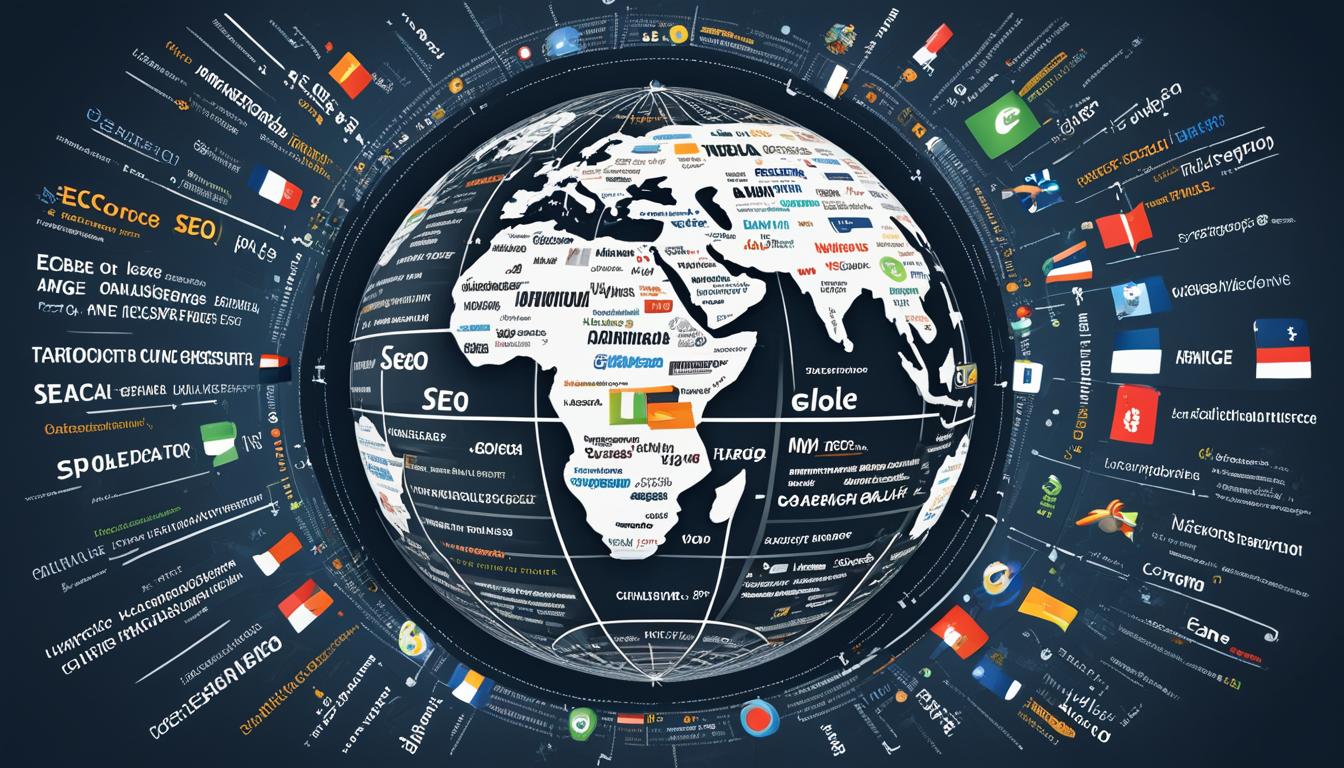Hey there! Today, I want to talk about a crucial aspect of website optimization: On-Page SEO for Different Languages. As our world becomes more interconnected, reaching a global audience is essential for businesses seeking growth and success. With effective multilingual SEO strategies, you can expand your online presence, engage with diverse markets, and boost your conversion rates. Let’s dive in!
When it comes to multilingual SEO, it’s not just about translating your content word for word. It involves adapting your website to cater to the specific needs and preferences of different language speakers. From optimizing language-specific meta tags to implementing hreflang tags, there are several key steps to follow to ensure your website resonates with international audiences.
Key Takeaways:
- International SEO optimization is crucial for expanding your online reach and driving more conversions.
- Keyword research in different languages helps you understand the search behavior of your target markets.
- Choose the best URL structure for your multilingual website to enhance indexing and language targeting.
- Translations for SEO require the involvement of human translators for accurate and culturally adapted content.
- Content localization goes beyond translation and includes adapting currencies, time zones, and image alt text.
Now that we’ve laid the foundation, let’s dive deeper into each of these steps and explore how you can optimize your website for different languages. By the end, you’ll have a solid understanding of how to improve your website’s visibility and attract a global audience. So, let’s get started!
Identify Your Target Markets and Conduct Keyword Research
To expand your business to international markets, it’s crucial to identify your target markets and conduct comprehensive keyword research. By understanding the search behavior and preferences of your potential customers, you can optimize your website to attract relevant traffic and improve your search engine rankings.
1. Identify Your Target Markets
Before diving into keyword research, it’s essential to determine the countries or regions where you want to expand your business. This step involves analyzing market demand, competitor analysis, and cultural considerations to identify the most viable target markets. Tools like Semrush’s Market Explorer can help with this process by providing valuable insights into search volume, competition, and potential customer demographics.
By conducting thorough research and identifying target markets with high search demand for your products or services, you can focus your efforts on countries where your business has the best chance of success. This targeted approach allows you to allocate your resources effectively and create a localized marketing strategy that resonates with your target audience.
2. Conduct Keyword Research
Once you’ve identified your target markets, it’s time to delve into keyword research in the language specific to each country. Conducting keyword research in a foreign language may be challenging, especially if you’re not familiar with the language. In such cases, consider hiring a native speaker or qualified translator to assist you in brainstorming seed keywords.
“Hiring a native speaker or translator can bring invaluable insights into the nuances of the local language and culture. This helps you uncover keywords that resonate with your target audience and improve the effectiveness of your SEO efforts.”
To expand your keyword list and gather metrics like search volume and keyword difficulty, utilize keyword research tools such as Semrush’s Keyword Magic Tool. These tools provide valuable data on keyword popularity and competitiveness, allowing you to select the most appropriate keywords for your content optimization.
By conducting thorough keyword research, you gain a deep understanding of the language preferences and search behavior of your target audience. This knowledge enables you to optimize your website content, meta tags, and other SEO elements effectively in each specific market, increasing your visibility and driving targeted organic traffic to your website.
Decide on the Best URL Structure for Your Multilingual Website

To ensure proper indexing and language targeting, it’s essential to choose the best URL structure for your multilingual website. The URL structure impacts how search engines and users perceive and navigate your site. There are several options to consider, each with its own advantages and considerations.
Separate Domains (ccTLDs)
Using separate domains for each language is a popular choice, especially for businesses targeting specific countries or regions. For example, if your main website is example.com, you can use example.fr for French and example.es for Spanish. This approach offers a sense of localization, making users feel they are in the right place. However, it requires a significant infrastructure investment and can be challenging to manage.
Subfolders within a Single Domain
Another common option is to use subfolders within a single domain. For instance, you can have example.com/fr for French and example.com/es for Spanish. This approach simplifies setup and management, as all language versions are within one website. However, keep in mind that using subfolders may limit the ability to use localized hosting, as it may not be available for all server configurations.
Subdomains
Subdomains are another possibility for structuring your multilingual website. For instance, you can have fr.example.com for French and es.example.com for Spanish. Subdomains offer more flexibility than subfolders and can be useful if you have different teams managing each language version. However, setting up and maintaining subdomains can be more complicated, and it may require building SEO authority for multiple domains.
Avoid URL Parameters
While URL parameters may seem like a convenient option, it’s generally best to avoid using them for multilingual websites. URL parameters can confuse search engines and make it difficult for them to understand the different language versions of your site. It’s better to choose a URL structure that clearly indicates the language and target audience.
Take the time to evaluate the pros and cons of each URL structure option and consider how it aligns with your website’s goals and resources. Whichever structure you choose, remember to implement proper hreflang tags to signal to search engines the language and geographical targeting of your webpages. This will help ensure your site ranks well and reaches the right audience.
Translate and Optimize Your Pages
When it comes to translating your website content, it’s crucial to involve a human translator rather than relying solely on automated translation tools. While these tools may seem convenient, they often produce inaccurate translations that can negatively impact user experience and search engine rankings.
During the translation process, it’s essential to not only focus on translating the on-page copy but also consider other elements that contribute to the overall user experience. Elements such as currencies, time zones, and image alt text should be carefully translated to ensure a seamless experience for international users.
As you translate your website content, optimizing it for each language is equally important. This involves writing language-specific title tags and meta descriptions that accurately reflect the page’s content and incorporate relevant multilingual SEO keywords. By doing so, you increase the likelihood of your pages appearing in relevant search results for users searching in their preferred language.
Additionally, pay attention to the URL slugs for your translated pages. Ensure they are short, descriptive, and use hyphens to separate words. Using lowercase text is also recommended for better consistency and usability. A well-optimized URL slug not only helps search engines understand the page’s content but also improves user experience by providing clear and meaningful URLs.
Another important aspect of optimizing your translated pages is the inclusion of internal links. Internal links guide users to relevant pages within the same language version of your site, enhancing navigation and overall user experience. They also help search engines understand the relationships between different pages, improving indexation and ranking.
In summary, when translating your website content, be sure to involve a human translator, optimize your metadata, including title tags and meta descriptions, pay attention to URL slugs, and incorporate internal links. By taking these steps, you can ensure that your multilingual website is both user-friendly and search engine optimized.
Conclusion
On-page SEO for different languages is essential for expanding your website’s reach and achieving high rankings in search engine results. By following the strategies outlined in this article, you can effectively optimize your multilingual website and attract a global audience.
The first step in multilingual SEO is identifying your target markets and conducting thorough keyword research in the country-specific language. Understanding the search volume and keyword difficulty in each language will help you create targeted and optimized content.
Next, you need to decide on the best URL structure for your multilingual website. Whether you choose separate domains, subfolders, or subdomains, make sure it aligns with your goals and allows for easy management and indexing.
Translating and optimizing your pages is another critical aspect of on-page SEO for different languages. Utilize the skills of a professional human translator to ensure accurate translations, and optimize your metadata, including title tags and meta descriptions, as well as URL slugs and internal links, to enhance your website’s visibility in search results.
Finally, don’t forget to implement hreflang tags to indicate language and geographical targeting to search engines, further improving your website’s performance in different regions.
By prioritizing accurate translations, localization, and providing a seamless user experience across languages, you can maximize the impact of your multilingual SEO efforts and achieve success in various international markets.










